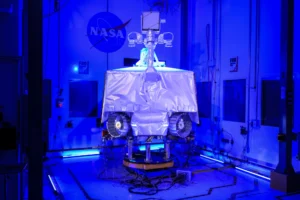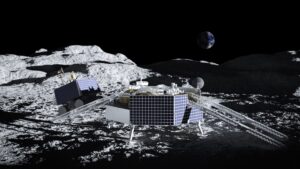VIPER Clears Acoustic Tests as Scientists Question Proposed Cancellation
NASA’s VIPER lunar rover completed acoustic testing today just a week after NASA announced its intent to terminate the mission because of cost growth. Congress will have the last word on VIPER’s fate and NASA is awaiting a response. In the meantime, testing continues to get the spacecraft ready for launch next year with many in the lunar science community hoping Congress tells NASA to change its mind.
Last week, NASA science Associate Administrator Nicky Fox and her deputy for the Exploration Science Strategy Integration Office, Joel Kearns, announced their decision to terminate VIPER because the cost has grown more than 30 percent.
When then-NASA Administrator Jim Bridenstine revealed the Volatiles Investigating Polar Exploration Rover (VIPER) project at the 2019 International Astronautical Congress, the estimated cost was $250 million. By the time NASA was ready to make a cost commitment to Congress it was $433.5 million, with landing expected in 2023. That slipped to 2024 and the cost grew to $505.4 million. Now it has slipped again to September 2025 with a cost of $609.6 million.
That’s more than 30 percent above NASA’s commitment, a threshold that requires congressional notification and triggers an automatic cancellation review. That review took place last month.
NASA has spent $450 million on VIPER already and Kearns said they would save just $84 million by canceling it assuming the September 2025 date holds. He’s worried, however, that the date will slip again and raise costs further either because of technical problems that might arise during environmental testing or delays in the lander that will deliver it to the lunar surface.
VIPER is already built and in the middle of those environmental tests at Johnson Space Center.
VIPER project scientist Anthony Colaprete, speaking from JSC to NASA’s Exploration Science Forum in St. Louis today, said VIPER has already cleared two of the tests — vibration and acoustic — and will soon enter thermal vacuum testing, the last in the series. The acoustic testing was completed today shortly before he began his talk. No significant problems have emerged so far.

Thermal testing is scheduled to begin August 21 and he doesn’t expect any surprises then either. “I’ll point out that every single element within the rover has already gone through its element level thermal vac, so, very low likelihood of significant issues as we move through thermal vac.”

NASA has another concern, though. The lander that will deliver VIPER to the Moon’s South Pole is being developed through a Public-Private Partnership with Pittsburgh’s Astrobotic under NASA’s Commercial Lunar Payload Services (CLPS) initiative. Astrobotic and other CLPS contractors design, develop, build and own the landers and procure launch services. NASA buys delivery services for its own science and technology payloads under a fixed-price contract and expects the companies to find other customers to close their business cases.

Astrobotic’s first CLPS mission earlier this year failed to reach the Moon, however. The company is still determining what changes must be made to the design of that lander, Peregrine, and to the larger version it’s building for VIPER, Griffin.
Kearns also spoke at the conference today and reiterated that the earliest Griffin now can be ready is September 2025 and Astrobotic has a lot of work to do between now and then. If the date slips further, VIPER will slip along with it, adding to the cost.
Colaprete pushed back on that: “we could easily store the rover and bathtub the team to a critical number of people for a fraction of the cost-to-go.”

NASA’s proposal is first to ask companies and international partners if they want to take over the program at no additional cost to the U.S. government. August 1 is the deadline to express interest. If there are no acceptable offers, NASA will disassemble the rover and try to find ways to fly the scientific instruments on future missions.
Colaprete said “we are tracking over 20 serious responses,” adding that in his personal view it would cost about all of the $84 million NASA says it would save by canceling the mission to pay for disassembling VIPER.
VIPER had lots of support from scientists in the audience. University of Notre Dame planetary geologist Clive Neal, for example, called the idea of disassembling VIPER “absurd given the investment already put into it by NASA.” He also urged NASA to keep the test schedule intact since a fully tested rover will be more attractive to potential partners.
On Thursday, NASA’s Lunar Exploration Analysis Group will hold a special Town Hall meeting at the conference to discuss it further.
Kearns explained how and why the “tough and disappointing decision” was made, reiterating the points from last week. The agency has notified the congressional appropriations committees and is awaiting a response. He said again that VIPER will not be canceled without congressional concurrence. He re-emphasized that the decision is not a reflection on the VIPER team, praising their excellent work especially in coping with supply chain disruptions stemming from COVID-19.
He also defended the CLPS program and Astrobotic’s development of Griffin. NASA is paying Astrobotic $323 million. That’s on top of the $609.6 million for VIPER itself.
That doesn’t change. Griffin will be launched with whatever commercial payloads Astrobotic signs up, but without VIPER. NASA will provide a mass simulator to take VIPER’s place.
Other CLPS contracts also will continue as planned.
In addition to Astrobotic’s Peregrine, a second CLPS mission was launched earlier this year, Intuitive Machines’ IM-1. It had its own challenges — tipping over on landing — but operated for several days becoming the first U.S. lunar lander since the Apollo program.
Two more CLPS missions are expected in the fourth quarter of this year: another IM lander with NASA’s PRIME-1 drill, and a Firefly lander that will deliver NASA payloads to the surface. An orbiter, Lunar Pathfinder, will ride along on that mission. Several other CLPS contracts have been awarded or are planned for 2025 and beyond.
User Comments
SpacePolicyOnline.com has the right (but not the obligation) to monitor the comments and to remove any materials it deems inappropriate. We do not post comments that include links to other websites since we have no control over that content nor can we verify the security of such links.